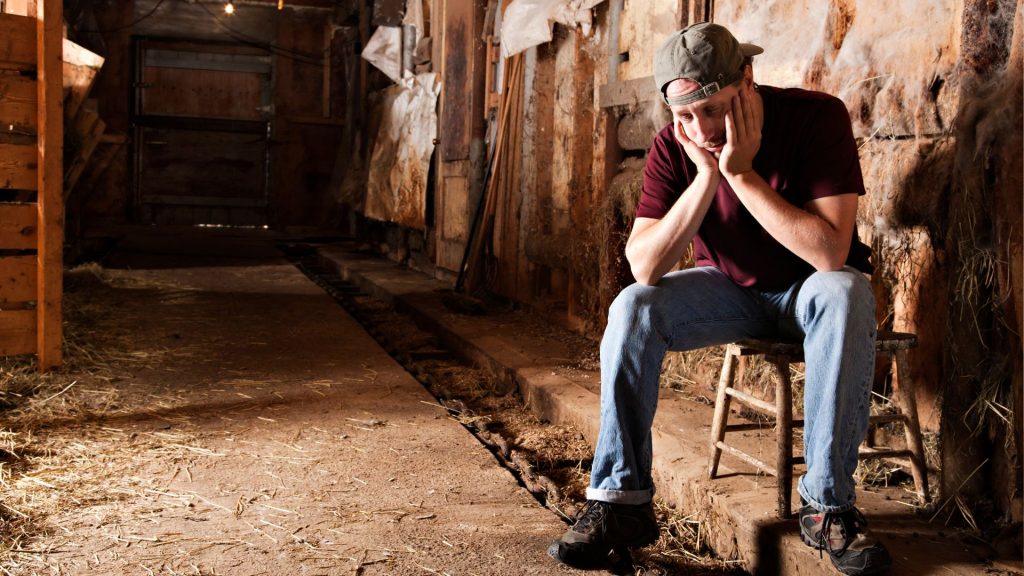Suicide Risk of Farmers & Ag Workers

Do you know which profession has the highest death-by-suicide rate in the United States? The answer might surprise you - farmers. Agricultural workers die by suicide at a rate three and a half times higher than the general population, according to the National Rural Health Association. Between 2000 and 2002, suicide rates increased 46% in non-metro areas compared to a 27% increase in metro areas, according to the Centers for Disease Control and Prevention.
Financial stress, limited access to mental health services, and a reluctance to seek help could be associated with the elevated risk of suicide among farmers, mental health experts say. Iowa farmer and psychologist Mike R. Rosmann, spent decades trying to better understand and address suicide risk in this population.
“Farming has always been a stressful occupation because many of the factors that affect agricultural production are largely beyond the control of the producers,” Rosmann wrote in the journal Behavioral Healthcare. “The emotional well-being of family farmers and ranchers is intimately intertwined with these changes.”

Mental Health Services and Farmers
Access to confidential crisis services and culturally competent mental health care is key to preventing suicide in agricultural populations, Rosmann explained. Josie Rudolphi, a professor of agricultural and biological engineering at the University of Illinois and co-director of the North Central Farm and Ranch Stress Assistance Center, explained that most farmers are independent producers who operate on very thin margins and mental health care is often considered a luxury or an unnecessary expense. Rudolphi said the geographical distribution of farmers is another challenge. They are scattered across the counties and states and not in one centralized workplace like a healthcare facility or university campus that would make mental health education and outreach easier. And their schedules are incredibly varied.
“We still see stigmatization around mental health in these communities, but I think that’s starting to change,” Rudolphi told the University of Illinois News Bureau in 2022. “Stigma seems to be more pervasive among certain demographics. For example, it appears as though it’s more challenging for older generations to talk about mental health issues. And in small communities, people are very conscious of other people knowing what their vehicles look like and not wanting people to recognize their car or truck parked outside a mental health clinic.”

Psychiatric Medical Care treats many current and retired agricultural workers in our different care environments. It is important to not only understand their increased risk, but to also understand interventions that can assist with lowering their risk for suicide.
Stress and Depression Checklist for Farmers
Professors at Colorado State University and the University of Wisconsin created a checklist and guide to help identify stress and depression in farm and ranch families. These signs can be observed by anyone, including friends, extended family members, neighbors, milk haulers, veterinarians, clergy, school personnel, or health and human service workers.
Signs of stress and depression include:
•Change in routines
The rancher or ranch family stops attending church, drops out of 4-H, Home makers or other groups, or no longer stops in at the local coffee shop or feed mill.
•Care of livestock declines
Cattle may not be cared for in the usual way; they may lose condition, appear gaunt or show signs of neglect or physical abuse.
•Increase in illness
Farmers or farm family members may experience more upper respiratory illnesses (colds, flu) or other chronic conditions (aches, pains, persistent cough).
•Increase in farm or ranch accidents
The risk of farm accidents increases due to fatigue or loss of ability to concentrate; children may be at risk if there isn’t adequate childcare.
•Appearance of farmstead declines
The farm family no longer takes pride in the way farm buildings and grounds appear, or no longer has the time to do maintenance work.
•Children show signs of stress
Farm and ranch children may act out, decline in academic performance or be increasingly absent from school; they may also show signs of physical abuse or neglect.
Signs of Suicidal Intent
- Anxiety or depression: Severe, intense feelings of anxiety or depression.
- Withdrawal or isolation: Withdrawn, alone, lack of friends and supports.
- Feeling Helpless and hopeless: Sense of complete powerlessness, a hopeless feeling.
- Alcohol abuse: There is often a link between alcoholism and suicide.
- Previous suicidal attempts: May have been previous attempts of low to high lethality.
- Suicidal plan: Frequent or constant thoughts with a specific plan in mind.
- Cries for help: Making a will, giving possessions away, making statements such as “I’m calling it quits,” or “Maybe my family would be better off without me.”
If you suspect someone is at risk of suicide there are a number of resources available to help. You may start by calling 988, the Suicide and Crisis Lifeline.
A study by the University of Illinois found that 45% of all farmer and rancher suicides in the last 15 years were committed by people aged 65 and older. Our Senior Life Solutions program in Kingsman, KS started using an idea created by the Suspenders for Hope Foundation. Working with a local hospital, they create Suspenders for Hope kits. According to Suspenders for Hope, in the days following a hospitalization or visit to a crisis center for a mental health crisis or suicide attempt, individuals often face stigma and shame and are at higher risk of attempting.
Their aim is to provide Suspenders4Hope kits to patients leaving emergency mental health and detox services equipping them with essential resources to help bridge the lethal gap between crisis services and connecting with outpatient treatment. The kits are designed to increase coping and destigmatize help-seeking. Suspenders4Hope kits include items that instill hope, develop emotion management skills, provide information about crisis resources, peer support, and patient education, and reinforce reasons for living.
The kit is intended to increase protective factors identified through research (mental healthcare, DBT skills, connectedness, life skills, harm reduction, peer support, self-esteem and sense of purpose, and personal beliefs that discourage substance use and suicide).
Learn more about our Senior Life Solutions program and how it helps older adults in rural communities who are experiencing depression, stress and anxiety.
If you or someone you know is in need of a behavioural health placement, behavioural health referral, or experiencing a mental health emergency or crisis, please do not use this website. Instead, use these crisis resources to speak with someone now or access local support.

